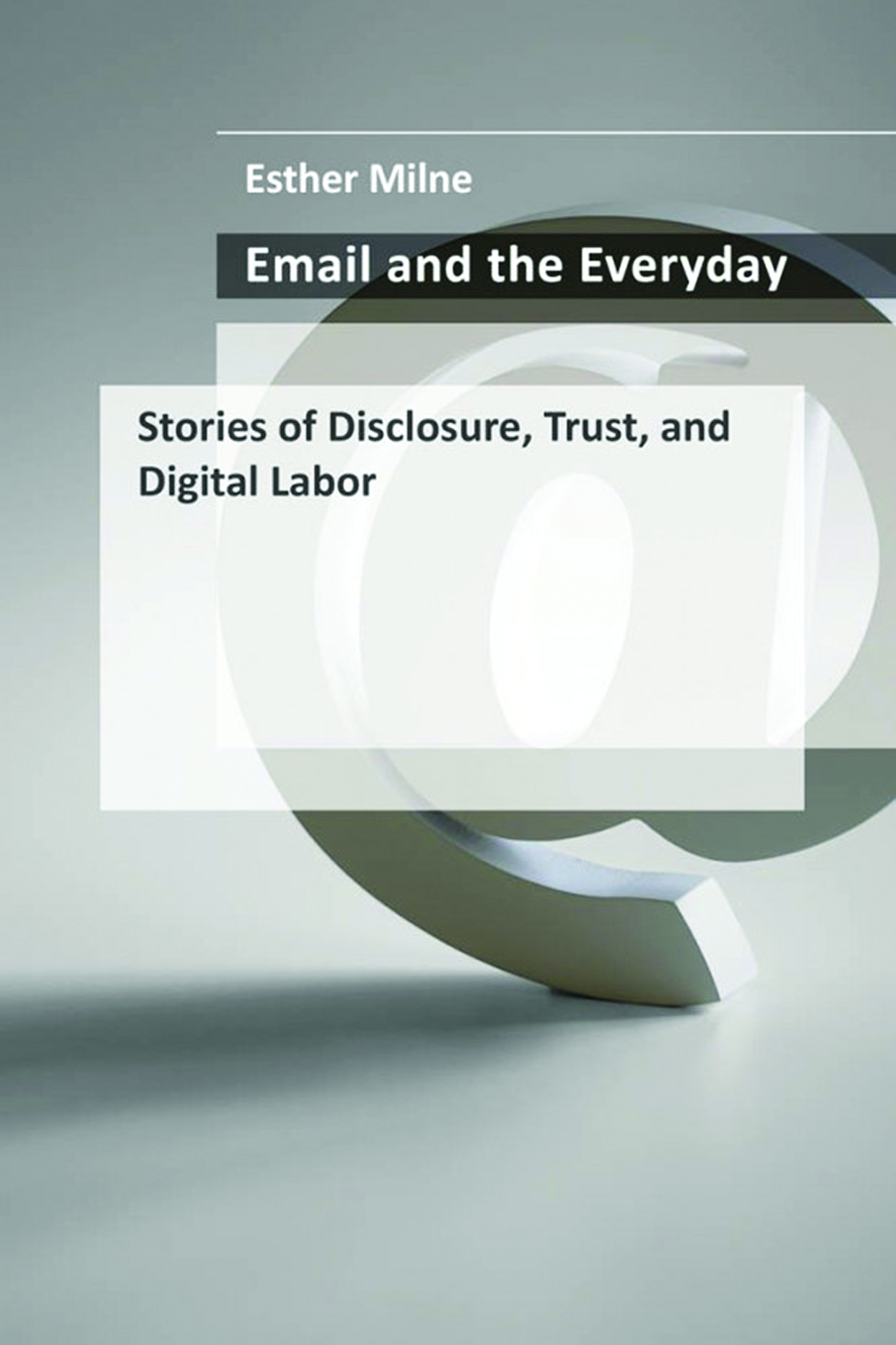Email has yet to really have its day in the academic spotlight, Esther Milne argues in the introduction to Email and the Everyday: Stories of Disclosure, Trust, and Digital Labor.2 This new book aims to recenter email as a complex part of digital culture and media studies. To do so, Milne traverses—among other things—historiographic debates about who “invented” email, a survey study of employees who negotiate email use as part of their work habit, and high-profile political cases such as the leak of Hillary Clinton’s emails to try and map “an interconnected, media specific field of practice and consumption” which “underpins so many of our daily interactions.”3 The book is sprawling and attempts to provide a comprehensive overview of email’s important place in a variety of digital cultural practices.
Milne takes storytelling as a key motif in this book, operating on three defined levels: “first, the stories of email refer to what people say in their emails to each other; then there are the stories of email circulation, publication, or archival . . . and finally there are the stories told about email in our public conversations.”4 Each section of the book focuses on a different kind of storytelling and uses a distinct mix of news stories, interviews, survey results, and existing histories and studies to locate, report, and analyze stories surrounding email. The book is attentive to some of email’s early developments in the latter half of the twentieth century but spends most of its time in the 2000s and 2010s, examining developments of workplace email governance, email leaks, and artistic pieces that ruminate on email’s banal place in everyday life.
The first section of the book, “Histories and Landscapes,” provides a broad overview of email’s early history as well as its contemporary industrial shape. Chapter 1, “The Origins of Email and Its Development,” summarizes various developments that contributed to email’s implementation. This chapter examines a variety of ways design had to be standardized to make email popular. Design is framed, following many approaches in science and technology studies, as a sociopolitical system. This chapter is rich in detail demonstrating how emergent technologies are wrangled and discussed in a variety of ways by their developers.
Chapter 2 pivots more into historiographic debates over who “invented” email, examining the controversy over Shiva Ayyadurai’s claims that he was the actual inventor of email. The information here, while certainly interesting, goes somewhat far afield of the book’s expressed commitment to the everydayness of email. Milne twists to try and make this fit, but it is indicative of a larger tension in the book: sometimes Email and the Everyday is about the stories that have emerged around and through email, and sometimes it is about email’s everydayness, but only rarely do those two things seem to intersect.
Chapter 3, “The Email Industry,” is perhaps the most interesting chapter for media industry scholars as it explores the scale of the email market through considerations of various email service providers, software programs, emoji, and analytics tools, with special attention paid to a case study of the company Fastmail, an email hosting service based in Australia and for which Milne conducted interviews with the company’s cofounder. This chapter sketches a complex terrain of competing companies and services and demonstrates one of the book’s goals.
The second section of the book, “Affect and Labor,” focuses on the ways email is part of larger management practices in a variety of workplaces and professional contexts. Chapter 4, “Bureaucratic Intensity and Email in the Workplace,” pivots to the workplace to consider issues like email surveillance and unintended emails to coworkers, such as what Milne calls “ ‘reply all’ disasters.”5 This chapter folds in details from Milne’s multinational survey of employees, but consideration of survey responses only covers about six pages of this chapter, leaving them somewhat underutilized.
Chapter 5, “Moderation and Governance in Email Discussion Forums,” uses examples of “affective management” to describe the work of moderators and managers in maintaining lists and ensuring ethical communication within and across the list. As with the previous chapter, Milne surveys interesting examples from academic listservs to shared interest communities, but each feels as if it deserves further analysis and attention.
The final section of the book, “Archives and Publics,” moves away from private workplaces or professional lists to consider how emails move through public awareness and how public lives are represented. Chapter 6 analyzes email leaks from the Enron database and the Hillary Clinton email server to examine how institutional email practices can suddenly and unexpectedly be made public. Chapter 7, “The Art of Email,” shifts the focus more toward what Milne calls “mail art,” or art that is created on or through email.6 These chapters shift the book into public conversations about email, either occurring through significant and impactful email hacks from public figures or major companies, or through artists attempting to create works that reflect and comment upon the roles of email in everyday life. The book concludes by reiterating its commitments to the histories, markets, and archives of email, with a call for media researchers and historians to avoid overlooking email and to instead see it as a site of “compelling stories.”7
The focus on storytelling, as useful as it is, sits uncomfortably with the book’s other overt commitments to everyday life. Early in the introduction, Milne says the book will avoid “high theorists” of everyday life, like Henri Lefebvre, who have traditionally been considered foundational (if, at this point, dated and with some significant blind spots).8 While the introduction engages with some everyday life theorists like Ben Highmore, the book is purposefully light on theorization. Milne justifies this by saying the book’s “approach leans toward the grounded, situated, or empirical perspectives of this critical terrain to trace the contours of lived experience read through the routines and vicissitudes of email.”9 This embrace of empirical mapping is consonant with many critical approaches in media studies, but the evasion of foundational theory acts largely as an alibi to avoid grappling with it. In a chapter on bureaucracy, for instance, Lefebvre’s ongoing critique of how bureaucracy reorders practices of everyday life could have provided detours into theory that could place the book within concepts to enhance the analysis of lived experience.10
While the book’s focus on history and discourse allows Milne to emphasize the complexities of the case studies in each chapter, the book also moves quickly through its various examples. In some chapters, like Chapter 3 on the Email Industry, this approach allows for a quick-paced tour of the development of email analytics companies. In other chapters, like Chapter 6 on Enron and Hillary Clinton, there is a sense of missed opportunity to provide even richer analysis of these complex moments in history. At times, Milne suggests a need to take more feminist approaches to everyday life, but the book lacks a substantive engagement with some of the major feminist theorists of everyday life. Including more feminist theory may have provided more nuance to some of the book’s important ideas about the relationships between technology, power, and practice in daily life. The evasion of theory throughout, in other words, is both a strength and an occasional weakness. At times, the commitment to everyday life feels at odds with the commitment to storytelling, and the book is at its best when it focuses more on stories told about and through email without trying to wedge these stories into a conceptualization of everyday life.
Methodologically, the book traverses historiography, interviews, multinational surveys, and discourse analysis of political and popular commentaries, as well as discussions of various artistic pieces meant to reflect on and engage email’s work in everyday life. As Milne notes in the introduction, the book “is an attempt to capture and make sense of such sociotechnical, affective practices in a critically systematic, materially situated, and evocative manner.”11 The book should not be confused for an ethnography or for a large-scale work of survey analysis. The multinational survey results are sprinkled throughout the book and are not explored as deeply as they might be. Media industry scholars will likely find the chapter on the email industry to be a useful overview, both as reference point and for teaching upper-level undergraduate courses on digital media industries, while the chapters detailing leaked work emails provide useful survey and interview responses that give dynamic shape to how individuals negotiate email throughout their days.
As a whole, Email and the Everyday seems split between at least two directions that don’t necessarily cohere: on the one hand, a commitment to making visible the invisible and banal intricacies of email use in everyday life and, on the other hand, a commitment to bringing together a variety of different stories about email use. Milne’s decision to favor more sensational incidents like the Hillary Clinton email scandal or the Enron email leaks means high-profile and internationally known examples are chosen to stand in for the supposed banality of daily email use. This tension pervades the book, suggesting that scholars interested in everyday life may find the book less valuable than those interested in storytelling or the public life of socio-technical systems like email. Still, the book’s mix of different methodologies and its broad scope make it a useful contribution for scholars of digital culture to continue engaging with everyday practices like email use.
Notes
- James N. Gilmore is an assistant professor of media and technology studies in the Department of Communication at Clemson University. He researches the articulations between technology, culture, and daily life as they manifest on digital platforms, wearable technologies, and other technical infrastructures.
- Esther Milne (2021), Email and the everyday: Stories of disclosure, trust, and digital labor. Cambridge: The MIT Press. ⮭
- Ibid., 207. ⮭
- Ibid., 209. ⮭
- Ibid., 115. ⮭
- Ibid., 188. ⮭
- Ibid., 222. ⮭
- Ibid., 13. ⮭
- Ibid. ⮭
- Henri Lefebvre (2016 [1967]), Everyday life in the modern world. New York: Bloomsbury. ⮭
- Milne, Email and the everyday, 12. ⮭


